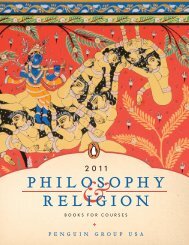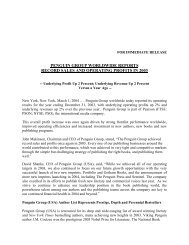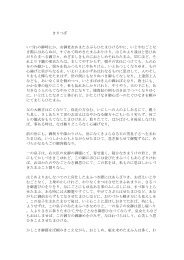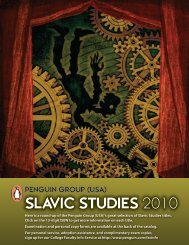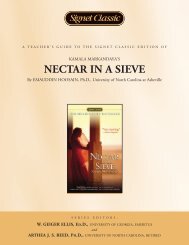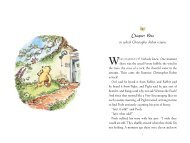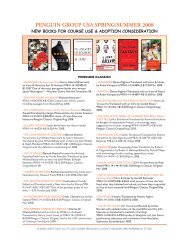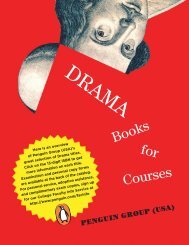KHALED HOSSEINI - Penguin Group
KHALED HOSSEINI - Penguin Group
KHALED HOSSEINI - Penguin Group
Create successful ePaper yourself
Turn your PDF publications into a flip-book with our unique Google optimized e-Paper software.
“The more Tariq talked, the more Laila dreaded the moment<br />
when he would stop. The silence that would follow,<br />
the signal that it was her turn to give account, to provide<br />
the why and how and when, to make official what he<br />
surely already knew.” (p. 337)<br />
“Mariam saw now in those same eyes what a fool she had<br />
been.” (p. 346)<br />
“I’ll never escape your son’s grief.” (p. 358)<br />
“God made us differently, you women and us men. Our<br />
brains are different. You are not able to think like we can.”<br />
(p. 365)<br />
“…she was leaving the world as a woman who had loved<br />
and been loved back.” (p. 370)<br />
Part Four Chapters 48-51<br />
1. How does Laila’s life in Murree contrast with her life<br />
in Kabul?<br />
2. Is Laila’s expectation that Zalmai will learn to accept<br />
his father’s absence realistic?<br />
3. Will Laila’s nightmares about her life in Kabul ever cease?<br />
What is the worst thing that happened to her there?<br />
4. Why is Laila afraid to hope for peace in Afghanistan,<br />
after the U.S. war on the Taliban is over?<br />
AFTER READING ACTIVITIES<br />
Discussion activities, thematic explorations, and creative<br />
exercises after reading the novel are designed to get students<br />
to re-read and think critically about their initial reactions.<br />
Most of these activities can be done with a partner or in a<br />
small reading circle. Again teachers should choose the activities<br />
that best meet their goals for students.<br />
1. Examine the role of religion in the lives of the main<br />
characters. Divide the class into three groups, assigned<br />
to Mariam, Rasheed, and Laila. Ask students to go<br />
back through the novel, noting the references to religious<br />
training, prayer, and the characters’ references to<br />
Allah, the Prophet, or the Koran. Based on this review,<br />
ask students to write a profile of the character, emphasizing<br />
their religious upbringing and orientation.<br />
Discuss as a group: Who is the most religious person<br />
in the novel? Why? What is the main motivating factor<br />
for each character?<br />
2. Compare Mariam and Laila by looking for pertinent<br />
passages which describe their family background, ed-<br />
5. What forces tug on Laila to return to Afghanistan?<br />
6 Why does Laila want to visit the home where Mariam<br />
had lived as a girl?<br />
7 How does the letter of Mariam’s father show his character?<br />
Does it redeem him in some way? In what ways<br />
is it ironic?<br />
8 What is fitting about Laila’s return to Kabul and her<br />
work at the orphanage?<br />
9 How do the drawings by the children in the orphanage<br />
express their experiences? How do they show the contrast<br />
between the time when Aziza was there and now?<br />
10 How has Mariam become a symbol of Kabul for Laila?<br />
Reader Response Quotes<br />
“Laila knows that this shameful lie will have to be told<br />
again and again.” (p. 379)<br />
“Kabul is waiting. Needing. This journey home is the right<br />
thing to do.” (p. 392)<br />
“Laila thinks of her own life and all that has happened to<br />
her, and she is astonished that she too has survived….”<br />
(p. 395)<br />
“…Mariam is in Laila’s own heart, where she shines with<br />
the bursting radiance of a thousand suns.” (p. 414)<br />
ucation, experiences, and character. Prepare a graphic<br />
organizer for each woman. Then discuss as a group:<br />
Do the women change in the novel? How? Who undergoes<br />
the most significant changes? How are the<br />
women similar? How different?<br />
3. While Rasheed is the overwhelming male presence in<br />
the novel, there are other male characters. Ask students<br />
to go back through the novel to identify the personality<br />
traits of other men in the novel. Write these lists<br />
on chart paper for easy comparisons. Look at Jalil, Babi,<br />
Zaman the orphanage director, and Sayeed owner of<br />
a small hotel in Murree who is kind to Tariq. What<br />
qualities do they have in common? How do they<br />
compare to Rasheed? How can you explain Rasheed’s<br />
behavior?<br />
4. Tariq says that he wrote letters to Laila, “volumes”<br />
(p. 338). Knowing Tariq’s history, first in Kabul and<br />
then as a refugee, imagine what he might wish to say<br />
to Laila from prison. Write the letter that Tariq<br />
would have written.<br />
7 A STUDY GUIDE TO <strong>KHALED</strong> <strong>HOSSEINI</strong>’S A THOUSAND SPLENDID SUNS




